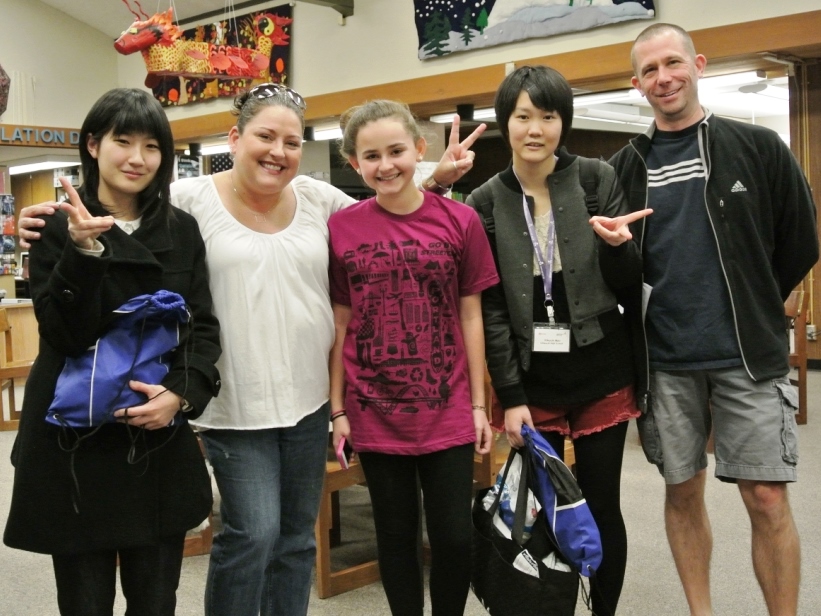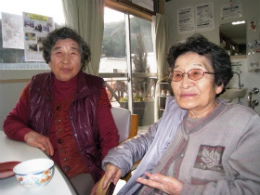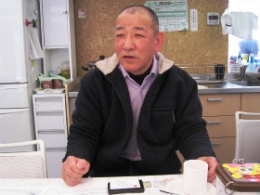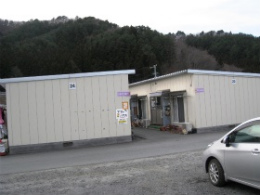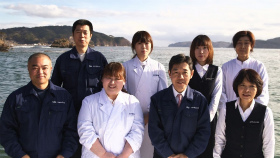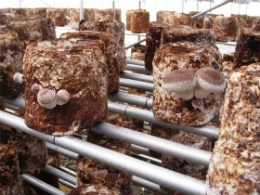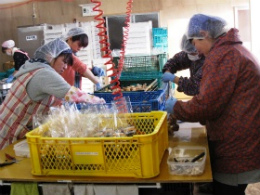実施日 : 2014年02月27日(木) - 28日(金)
Notice: Press Tour to Iwate Coastal Areas, 3 Years after the Earthquake
投稿日 : 2014年02月10日
~ Today’s tsunami-affected areas. Rebuilding status of lives and industry ~
Otsuchi, Kamaishi, Rikuzentakata
Nearly three years have passed since the Great East Japan Earthquake occurred on March 11, 2011.
Approximately 400,000 houses were completely or half destroyed in the earthquake, and many people lost their homes. While some people are rebuilding their homes, there are still 274,000 people living as evacuees.
The FPCJ has been carrying out press tours to areas affected by the disaster every year since 2011. After traveling to Miyagi in 2012 and Fukushima in 2013, this year the tour will visit the coastal areas of Iwate that were gravely damaged by the tsunami and examine the state of reconstruction of industries such as fishery and agriculture.
In this press tour, Governor Ta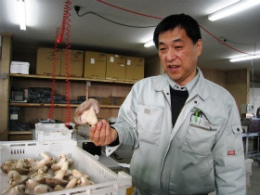 kuya Tasso of Iwate Prefecture will be interviewed regarding the progress of reconstruction and future plans. The tour will visit a temporary housing to hear from the people who are living there. The tour will also cover a fishery processing company that had its plant washed away in the tsunami, a mushroom producer attempting to create jobs in the area, and a temporary shopping district set up by businesses that lost their shops. There will also be a visit to a high school in Otsuchi Town, which lost approximately 8% of its town residents, to speak to students.
kuya Tasso of Iwate Prefecture will be interviewed regarding the progress of reconstruction and future plans. The tour will visit a temporary housing to hear from the people who are living there. The tour will also cover a fishery processing company that had its plant washed away in the tsunami, a mushroom producer attempting to create jobs in the area, and a temporary shopping district set up by businesses that lost their shops. There will also be a visit to a high school in Otsuchi Town, which lost approximately 8% of its town residents, to speak to students.
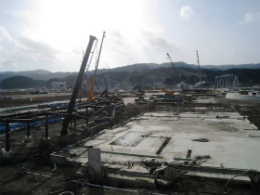 There are moves to preserve some destroyed buildings to keep the memory of the earthquake alive, as debris disposal and leveling proceed. The tour will visit a commemorative facility for prayers and an "earthquake memorial" that is being preserved in Rikuzentakata. Tour participants can also view there the leveling of the ground that is being undertaken on a large scale.
There are moves to preserve some destroyed buildings to keep the memory of the earthquake alive, as debris disposal and leveling proceed. The tour will visit a commemorative facility for prayers and an "earthquake memorial" that is being preserved in Rikuzentakata. Tour participants can also view there the leveling of the ground that is being undertaken on a large scale.
【 Topics 】
1. Press Conference by Iwate Prefecture Governor Takuya Tasso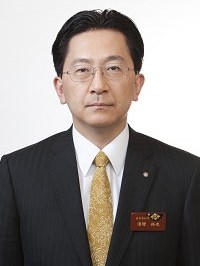
~ Working to Ensure Safety, Rebuild Lives, and Reinvigorate Livelihoods~
http://www.pref.iwate.jp/governor/index.html
In Iwate Prefecture, the disaster resulted in 4,672 deaths, 1,142 missing persons, and 25,023 houses collapsed. Many people lost their homes, and as of December 2013 there were 34,044 people living in 14,809 emergency temporary houses. The tsunami left behind 5,250,000 tons of debris in the prefecture, with 82.7% of it disposed of as of the end of October 2013, and all of the debris is expected to be cleared by the end of March.
Governor Tasso has stated that the goals of prefectural reconstruction plans are "Protecting lives, coexisting with the sea and earth, and creating our hometown of Iwate, Sanriku", with the three main principles of reconstruction being ensuring safety, rebuilding lives, and reinvigorating livelihoods. The duration of the project is 8 years. The first 3 years of the project were the "Initial Phase: Foundation Reconstruction Period" and end with the 2013 fiscal year, and starting from the 2014 fiscal year (April 1, 2014) the next 3 years are the "Major Reconstruction Period".
◆ This press tour will have an interview with Governor Tasso, asking him about progress of reconstruction, prefectural efforts and his vision for the future.
2. Students of Otsuchi Iwate Prefectural High School
~ Youth Who Visited the US to Tell High School Students about Living in an Area Affected by Disaster~ (Otsuchi Town)
http://www2.iwate-ed.jp/oht-h/
http://www.mofa.go.jp/j_info/visit/incidents/kizuna_project.html
http://sv2.jice.org/kizuna/e/what/about/
http://www.geocities.jp/peacefulworld10000/
The urban area of Otsuchi Town was devastated by the tsunami, which reached a maximum height of 22.2 meters. The combined number of deaths and missing persons was 1,235, approximately 8% of the population. The town hall was also hit by the tsunami, resulting in the deaths of 40 staff members including the mayor of Otsuchi. One third of the town residents are still living in temporary housing.
Otsuchi High School avoided the tsunami as it was on higher ground, and was used as an evacuation site for 5 months after the earthquake, with nearly 1,000 residents living there at the peak. Many of the students at this school are still living in temporary housing. Two years after the earthquake, in March 2013, the students of Otsuchi High School visited the United States as part of the Kizuna Project organized by the Japanese Ministry of Foreign Affairs. Nineteen students speaking in English, told their American counterparts in Seattle and San Francisco about living in an area affected by disaster and their feelings about their hometown.
There is also a group of students at this same school that proposed to the town hall their own strategy for town development for reconstruction. Town officials said they would like to reflect young people’s opinions in future policy.
Ms. Akane Kanezawa (17) of the same school was also appointed the "High School Student Peace Ambassador" (Organizer: "Hiroshima Nagasaki Peace Messengers" citizen's group), and in August of 2013 visited the United Nations Office in Geneva, Switzerland. In addition to delivering a petition for the abolition of nuclear weapons signed by high school students from around the country, she also spoke about the disaster-affected areas and nuclear abolition.
◆ This press tour will visit Otsuchi High School and speak to the group of students that visited the US, the group that proposed their strategy for town development, and to Ms. Akane Kanezawa, who was appointed "High School Student Peace Ambassador".
3. Residents of Temporary Housing "Heita Temporary Housing Complex No. 6"
~ Living as an Evacuee for 3 Years since the Earthquake. Building a Community by Residents and Supporters~ (Kamaishi City)
http://heitaparktown.sakura.ne.jp/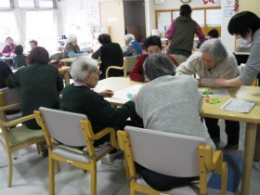
Heita Temporary Housing Complex No. 6 is one of the largest temporary housing complexes in the prefecture, with 430 people living in 221 residences. In addition to the "General Zone", the complex also includes a "Child-raising Zone" for families with children and a "Care Zone" for elderly residents. The residences in the Care Zone have monitors installed with a line to a support center in the complex, and the support center staff regularly visit the homes of elderly residents to check on them and deliver meals. The support center includes a clinic, and also functions as a meeting area for elderly temporary housing residents, where they gather to check their blood pressure and drink tea. In addition to caring for the elderly temporary housing residents, it also functions as a daytime nursing care services business for the area, with seniors visiting from outside the temporary housing complex as well.
The "Heita Park Temporary Complex Town Development Council" is made up of the residents’ association, NPOs, university faculty and the support center which has been commissioned by Kamaishi City, with the goal of creating a community together as a single "town". There is a 24-hour community television station within the complex.
Ms. Fuji Takahashi, eighty year old complex resident evacuated outside Kamaishi City for a time, but said "My hometown of Kamaishi is the best in the end. I am concerned about the future, but I do enjoy meeting with my friends every day at the support center."
◆ This press tour will visit Heita Temporary Housing Complex No. 6 and speak to residents including Mr. Isao Moriya (72), chairman of the residents’ association, about current conditions 3 years after the earthquake, and plans for the future. The support center on site will also be visited.
4. Onofoods Co., Ltd. Development and Sales Team Leader Mr. Kazuhiro Murakami
~ Fishery Processing Business that Recovered by Developing Products with High Added Value ~ (Kamaishi City)
The coastal area of Iwate Prefecture was known as a bountiful fishing area thanks to the Kuroshio Current. The tsunami washed out or damaged most of the fishery processing facilities in the prefecture. Onofoods, which produced and distributed processed fishery products in the coastal areas of Kamaishi City and Otsuchi Town, faced heavy losses from the tsunami. Their plant was half destroyed, and the call center they had only completed the month before was washed away. All the employees pitched in to repair the plant as quickly as possible, making it possible to resume operation 3 months after the earthquake, but their distribution routes for professional use, such as to restaurant chains, that had made most of their sales had already been taken over by other suppliers. Instead, the company decided to focus even more heavily on direct sales to general consumers, which they had started to concentrate on before the earthquake. "There were also some customers who said they would wait until we could ship again," Mr. Murakami said. The call center would carefully listen to customer requests, which were then reflected by developing products such as stewed fish and grilled fish. With individually frozen portions that could be easily heated and eaten quickly, as well as menus developed based on customer desires, they gradually increased the number of repeat customers, and have recovered beyond the level of sales they had before the disaster.
◆ This press tour will ask Mr. Murakami about the situation at the time of the earthquake, the path to reconstruction, and future plans and issues. There will also be an opportunity to view product development.
5. Kinoko no Sato Co., Ltd. President Mr. Hirofumi Sato (53)
~ Mushroom Producer Aiming to Create Jobs in His Hometown ~ (Rikuzentakata City)
http://www.kinoko-no-sato.com/index.html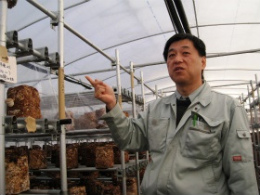
Kinoko no Sato Co., Ltd. faced significant damage from the tsunami, which washed away 8 of 18 mushroom cultivation facilities, as well as the company office. Company president Mr. Hirofumi Sato also lost his house in the tsunami, but continues to fight to rebuild his hometown that had been covered in debris. Believing that land covered in sea water could still be used in the horticultural cultivation of mushrooms, he rented the surrounding land that had been rice paddies. With his desire to create jobs, he increased the number of greenhouses to 27, more than before the earthquake, and the number of employees also increased from 15 to 45. Although operating the business is not simple even with subsidies, Mr. Sato said "Creating jobs is an important goal for someone running a business in a small town. There are many store owners who lost their stores in the earthquake. I would like to create more jobs, even if it is only 1 or 2." His goal is to complete 50 greenhouses by 2015, and create 100 jobs. The sea breeze is said to impart a unique flavor to the shiitake mushrooms, which are well received.
◆ This press tour will view the process of mushroom cultivation and interview Mr. Sato. He will be asked about the situation at the time of the earthquake, the path to reconstruction, and future plans and issues.
6. Temporary Shopping District "Otsuchi Kitasho Fukko Kirari Shotengai"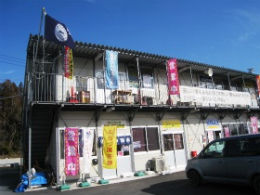
~ Store Owners Supporting the Lifestyle of Local Residents ~ (Otsuchi Town)
http://tohoku-monogatari.org/p/fukko04.html
A temporary shopping district made of prefab buildings in what used to be the schoolyard of Otsuchi Kita Elementary School, which was hit by the disaster. People who lost their stores in the earthquake are continuing their businesses here. There are approximately 40 stores that are part of people's daily lives, including restaurants, fish markets, beauty parlors and banks. This is a place to relax not only for the local people living in temporary housing, but also for workers staying in the area as part of reconstruction efforts.
◆ This press tour will visit the temporary shopping district. The chairman of the shopping district, Mr. Shigeru Yamazaki (66), will speak, and stores may be visited.
7. Kamaishi Kitchen Car Project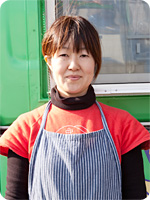
~ Local Youth Support the Area with Food Carts~ (Kamaishi City)
The Kamaishi Kitchen Car Project was started by the Kamaishi Otsuchi Industrial Research Development and Training Center with the goal of supporting restaurant owners whose restaurants were damaged in the earthquake by lending them mobile kitchens to help restart their business. As some of these businesses have left the kitchen cars and got their own restaurants again, locals in their twenties and thirties have been using the kitchen cars as an opportunity to start their own new businesses. They include people in their thirties who have returned from the big city, and a 20 year old who lost his home in the earthquake.
◆ This press tour will visit a square where the kitchen cars gather. In addition to speaking with the young entrepreneurs, the food they prepare will be eaten for supper.

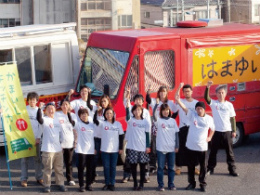
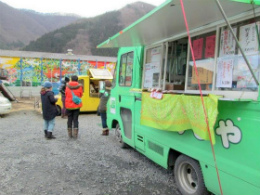
8. Earthquake Memorial "Former Tapic 45"/ Commemorative Facility for Prayers
~ Preserving the Memory of the Earthquake for Future Generations ~ (Rikuzentakata City)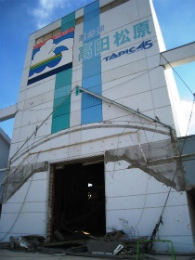
"Tapic 45" was the Rikuzentakata information station (Roadside Station). The tsunami reached the roof of this facility, and it was decided to leave it as it was along with the debris, as an "earthquake memorial". There are various arguments about what to do with buildings affected by the disaster, but the mayor of Rikuzentakata City decided early on a policy to preserve buildings which (1) Wouldn't impede people's lives in the future, and (2) Had no fatalities at the site.
A commemorative facility for prayers was also built beside Tapic 45. After the earthquake, damaged public buildings such as the old city hall and gymnasium served as places for residents to pray for their lost ones, but as they were dismantled this memorial facility was installed as a place to commemorate the dead. The outer walls use pine trees damaged by the disaster, and inside are photos of before and after the disaster. The city plans to preserve this memorial facility, Tapic 45, and the "Miracle Pine (*see 9) as part of an earthquake memorial zone.
◆ This press tour will visit Tapic 45 and the commemorative facility for prayers. A representative of Rikuzentakata City will explain the purpose behind preserving memorials.
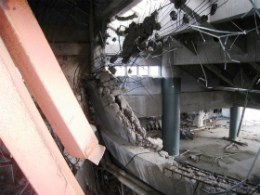


9. Miracle Pine
~ A Symbol of Reconstruction Supported by Donations from Around the World ~ (Rikuzentakata City)
http://www.city.rikuzentakata.iwate.jp/kategorie/fukkou/ipponmatu/ipponmatu.html
Pine forests, along the Pacific Ocean coast in Rikuzentakata City, had 70,000 pine trees growing there thanks to 350 years of planting trees. Famous as one of the 100 Landscapes of Japan, the tsunami hit this pine forest and destroyed it. Afterwards, a single pine tree was found still standing, and it became known as the "Miracle Pine" and became a symbol of the reconstruction. Although the miracle pine resisted the tsunami, it was determined to be dead one year later due to damage from sea water. The city decided to retain the pine as a monument, as it had become a symbol of the reconstruction. The tree was reinforced, treated with preservative, and had replica branches added before being returned to its original location. The preservation was a point of contention due to the cost of the procedure, but donations from not only Japan, but from around the world, covered the 150 million yen restoration cost.
◆ This press tour will ask Rikuzentakata City officials about the debate over preservation and donations, and view the "Miracle Pine".
The tour will also view the large-scale ground leveling that is being carried out.
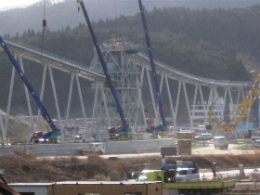

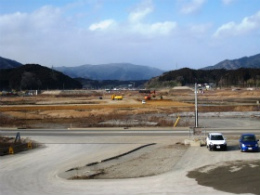
【 Tour itinerary and application details 】
1. Itinerary (Tentative): February 27 (Thu) and 28 (Fri), 2014
<Day 1: Feb. 27 in Morioka City, Otsuchi Town, Kamaishi City>
7:30 Depart from Tokyo (by bullet train Komachi 23: 2 hours and 27 minutes)
9:59 Arrive in Morioka
10:30-11:30 Press Conference by Iwate Prefecture Governor Takuya Tasso
(Move from Morioka to Otsuchi by chartered bus: 3 hours and 30 minutes, including lunch on the way)
15:00-16:30 Students of Otsuchi Iwate Prefectural High School
16:30-17:30 Temporary Shopping District "Otsuchi Kitasho Fukko Kirari Shotengai"
18:00 Check in at the hotel
18:45-20:15 Kamaishi Kitchen Car Project (Interview and dinner)
20:20 Arrive at the hotel in Kamaishi
<Day 2: Feb. 28 in Kamaishi City and Rikuzentakata City>
8:00 Leave the hotel
8:30-10:00 Onofoods Co., Ltd. (Fishery Processing Business)
10:30-12:00 Residents of Temporary Housing "Heita Temporary Housing Complex No. 6"
12:30-13:15 Lunch
14:00-15:15 Kinoko no Sato Co., Ltd. (Mushroom producer)
15:30-16:30 Earthquake Memorial "Former Tapic 45"/ Commemorative Facility for Prayers
Miracle Pine
16:30-18:10 Move from Rikuzentakata to Ichinoseki by chartered bus (1 hour and 40 minutes)
18:40 Leave Ichinoseki for Tokyo (by bullet train: 2 hours and 15 minutes)
21:12 Arrive in Tokyo
2. Qualification: Bearer of Gaimusho Press Registration Card
3. Cost: 13,000 yen per person including transportation, meals and accommodation.
* FPCJ will later inform the participants of methods for payment, cancellation fee etc.
4. Participants: Limited to the 15 applicants
(Only one reporter and one photographer from each company, but two participants from each TV team will be acceptable.)
If the number of applicants exceeds 15, an upper limit may be set on the number of participants from each country.
5. FPCJ Contact: Ms. Chika Yoshida (Tel: 03-3501-3405)
6. Remarks:
(1) There may be some restrictions on photographing and filming at the tour sites. Please follow the instructions of the officials on duty.
(2) FPCJ will not be liable for any inconvenience, trouble or accident that might occur in the course of the tour.

